Did you know that, unlike humans, fish can also have teeth on their jaws, aka pharyngeal teeth?
Some also have near-microscopic teeth on their tongues!
Moreover, quite a few species – like sharks – are also popular to have continuous tooth regeneration. Some of them can grow new teeth within just 24 hours!
There are so many fascinating fish species with unique teeth and various distinct uses. Some of them are bound to drop your JAWS!
So, to know more about some of the toothy fish, all you need to do is dive… not in the ocean… but in this article!
What is a Fish with Teeth?
Fish with teeth is a fish that has teeth which show up when it opens its mouth. There are several different types of teeth that fish have with round, sharp, buck type and pointed teeth being the most popular.
In late 2015, a picture of a “mysterious” fish with human-looking teeth went viral. Many even claimed it was a photoshopped picture… only to discover it was a pacu. But well, there are lots of species with similar teeth, so let’s get to know them…
1. Sheepshead Fish (Archosargus probatocephalus)
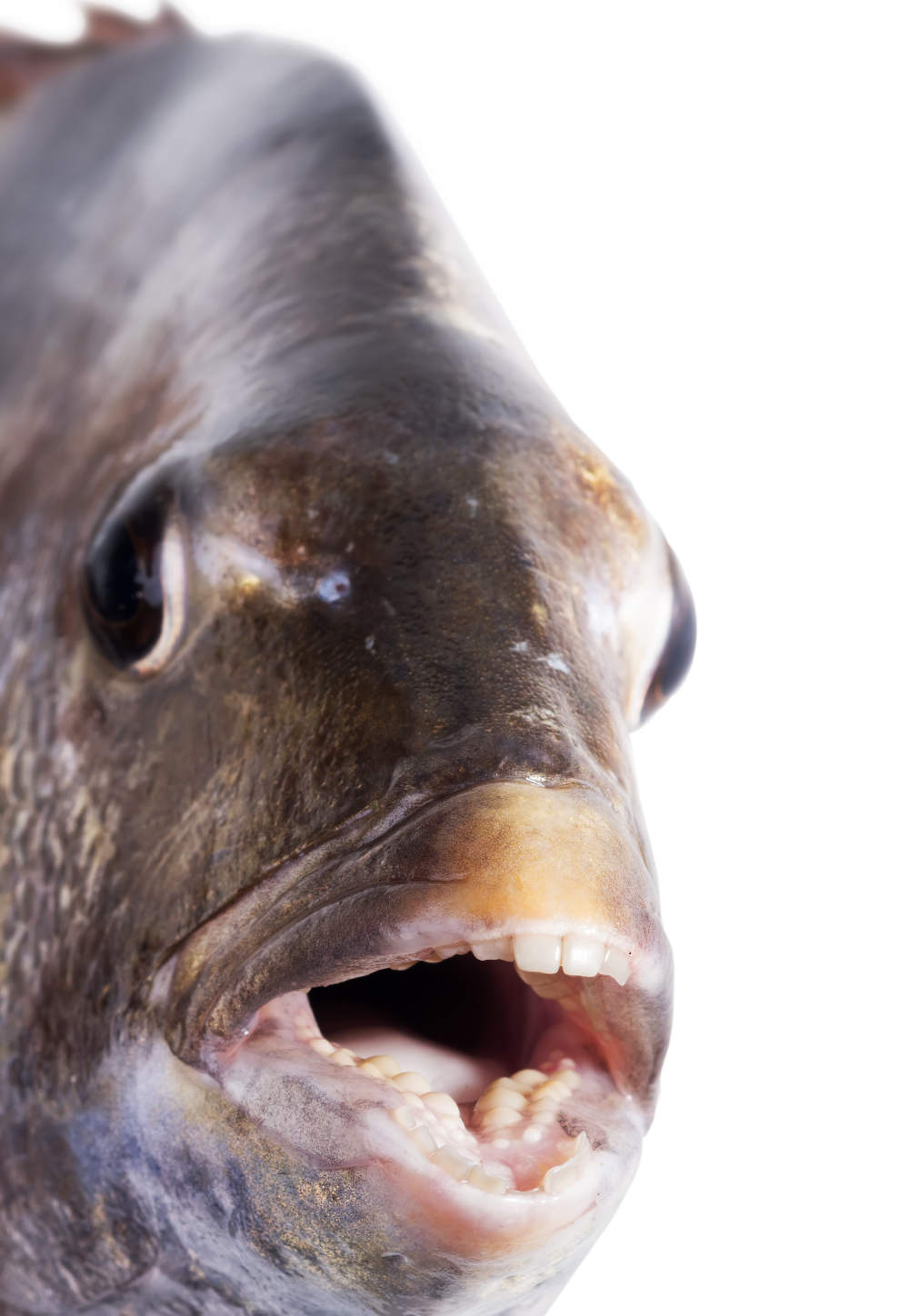
The omnivorous bottom feeder from the Sparidae family, scientifically described by scientist Theodore Nicholas Gill (1865), is native to the western Atlantic Ocean around North and South America.
Named after a sheep-like face, it reaches up to 91 cm (3 ft) in length and 9.6 kg (21.2 lb) in weight.
This usually peaceful euryhaline fish has multiple rows of stubby teeth. Its front teeth on the upper jaw are extremely identical to human teeth, with well-defined, thin, and sharp incisors. There are also several flat and rounded molars, functioning as grinders on both jaws.
The sheephead breaks hard-shelled invertebrates with its teeth to feast on them.
2. Titan Triggerfish (Balistoides viridescens)
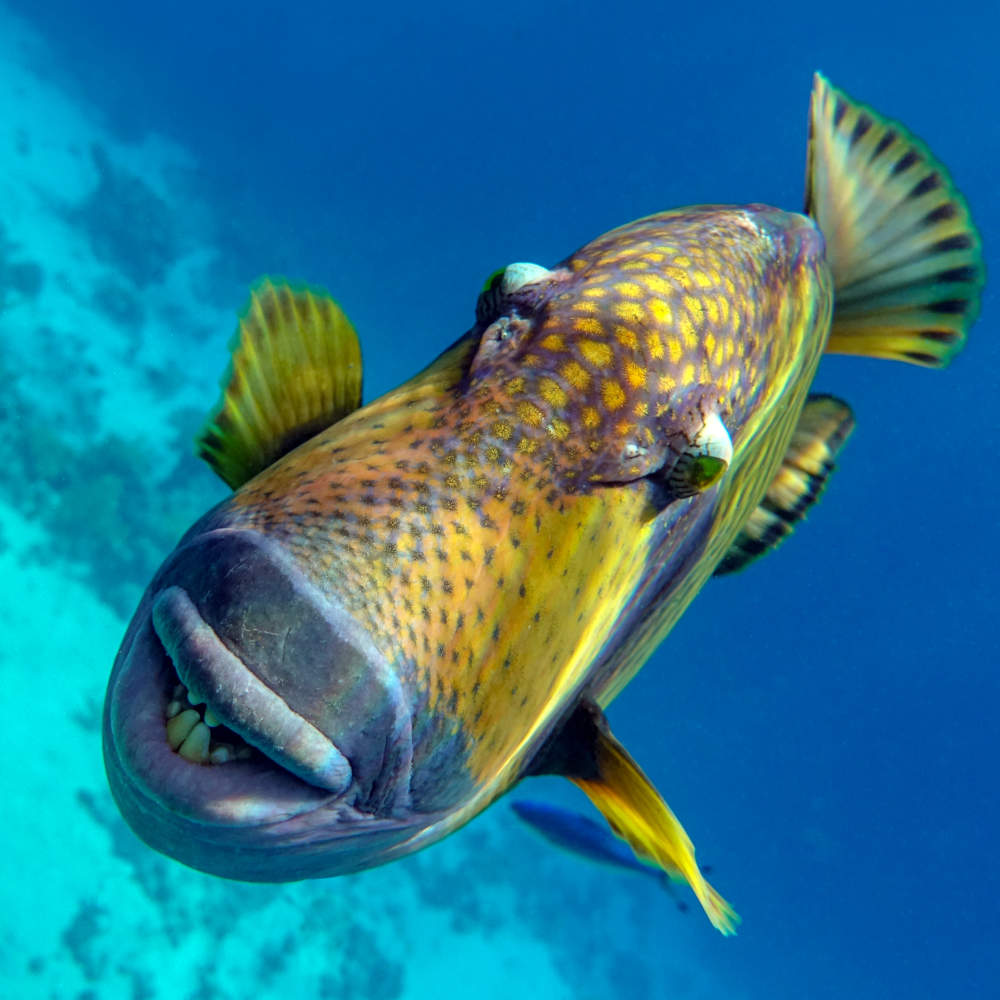
From the Balistidae family, the territorial and aggressive carnivore is known to reach up to 75 cm (2.4 ft). It is found in the Indo-Pacific coral reefs near East Africa, North Australia, South Japan, and more. The fish was scientifically described by Bloch & Schneider (1801).
Though all triggerfish have human-like teeth, the titan triggerfish has the largest and most powerful teeth. The marine predator uses the teeth to bite through clams, oysters, and corals.
Further, its bite is a serious threat to inattentive divers and fishermen near its habitat.
3. Giant Pacu (Colossoma macropomum)

From the Serrasalmidae family and described by Cuvier (1816), the freshwater omnivore lives in the high-nutrient whitewater rivers of the Amazon and Orinoco basins in South America. The round middle dweller grows up to 108 cm (3.5 ft) in length and 40 kg in weight.
This elongated fish has straight, square, human-like teeth. The upper jaw has two rows of multi-cusped molar-like teeth and two rows on its mouth roof. Its lower jaw flaunts a single row of similar teeth with conical teeth in the front.
The blunt-toothed giant pacu, known for its strong bite among fishermen and swimmers, mainly uses its teeth to crack seeds and grind plants.
Which are Fish with Big Teeth?
Many fish have teeth much larger compared to their entire body. They may be unable to close their mouth for the big teeth or have unique ways to fit them in. So, let’s know more about some interesting ones here…
4. Deep-sea Fangtooth (Anoplogaster cornuta)

The carnivorous, aggressive hunter from the Anoplogastridae family – described by Valenciennes (1833) – is native to temperate and tropical waters of the Indian, Pacific, and Eastern and Western Atlantic Oceans. The middle-to-top dweller grows up to 18 cm (7 in).
As its name suggests, the scary saltwater species has massive, fang-like teeth protruding from its mouth. The curved teeth don’t let the fish close its mouth completely. Two big lower jaw fangs have sockets on the upper jaw to fit in.
The common fangtooth’s teeth help the fish catch, hold, and feast on its prey. The fish is known for having the greatest teeth-to-body-size ratio among marine species.
5. Sloane’s Viperfish (Chauliodus sloani)
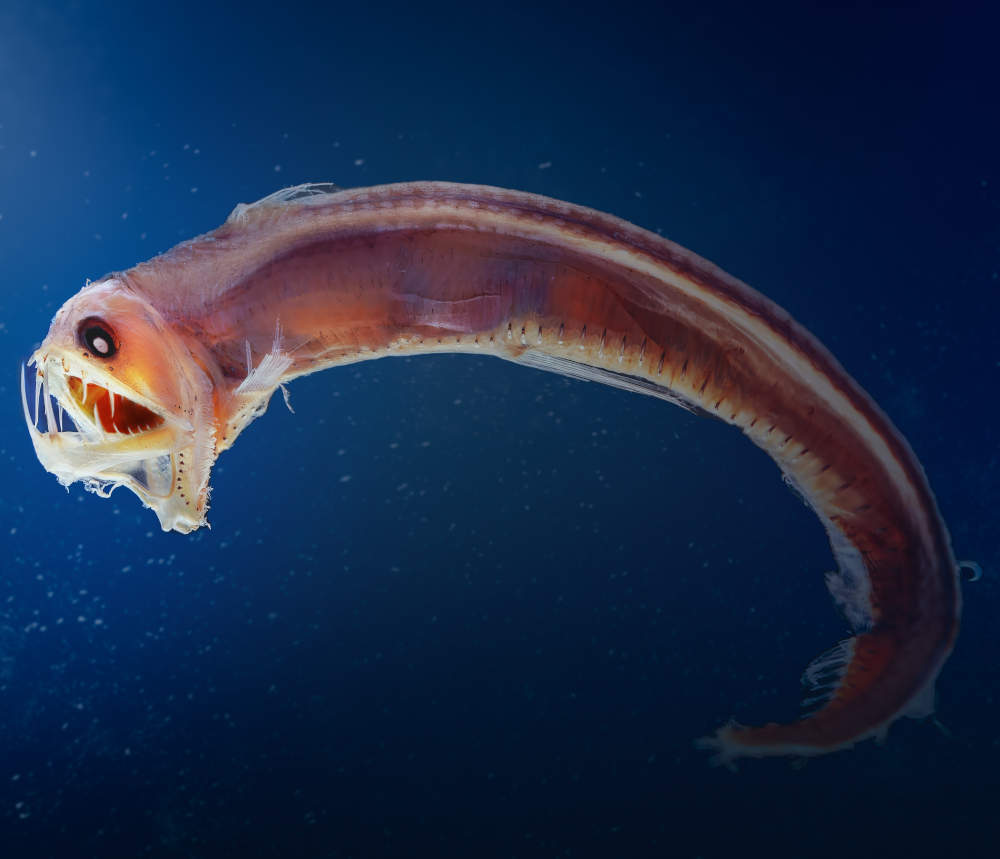
Native to the western Mediterranean Sea and Atlantic, Pacific, and Indian Oceans, the Stomiidae family species is known to grow up to 35 cm (1.2 ft). German scientists Marcus Elieser Blocj and Johann Gottlob Schneider first described it (1801).
The primarily carnivorous deep-sea predator has enormous teeth. When the slender compressed fish closes its jaws, the needle-like teeth make a cage-like structure – perfect for trapping prey and tearing them apart.
Due to the gigantic teeth, the venomous marine fish has to open its mouth to almost 90° to fit in prey. The largest teeth are almost half the size of the deep sea-dweller’s head.
6. Deep-sea Dragonfish (Grammatostomias flagellibarba)
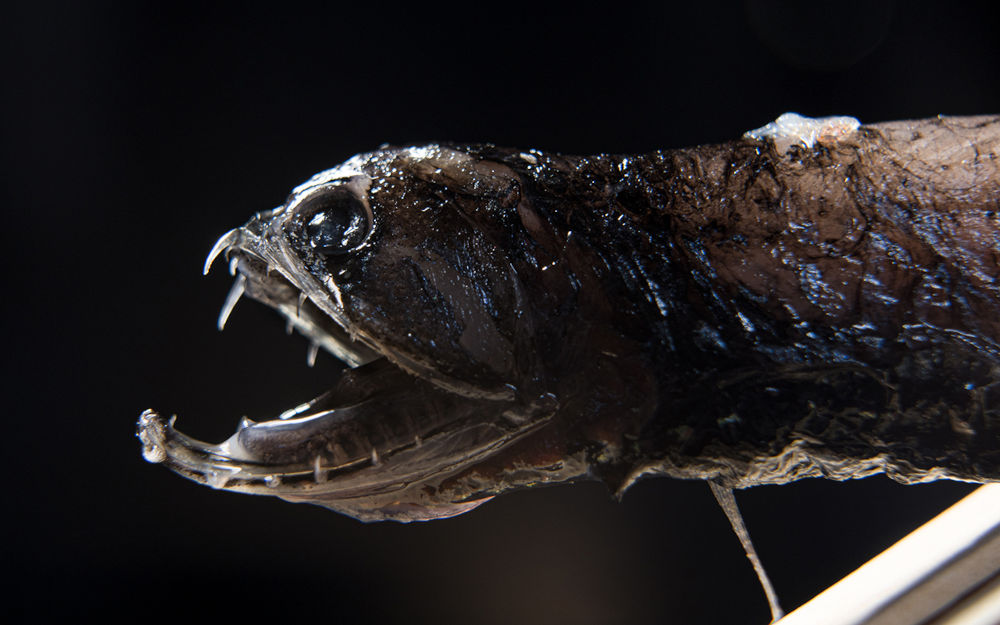
Another marine Stomiidae family member, scientifically described by Holt & Byrne (1910) – from the North Atlantic Ocean off southern Ireland and the Bay of Biscay, is known to grow up to 15 cm (6 in).
This elongated, fierce-looking, cunning predator lures in prey using its photophores (light-emitting organ), pierces and tears them with its sharp, strong, curved fangs.
The deep sea dragonfish’s large teeth (compared to the fish’s body) also produce a special enzyme that dissolves the prey meat and helps its digestion.
Which are the Fish with Buck Teeth?
Buck teeth or overbite is when the top jaw teeth protrude and overlap the lower jaw. Though this misalignment is common in only 22% of humans, some fish species have it as a permanent feature. So, let’s know about one here…
7. Bumphead Parrotfish (Bolbometopon muricatum)
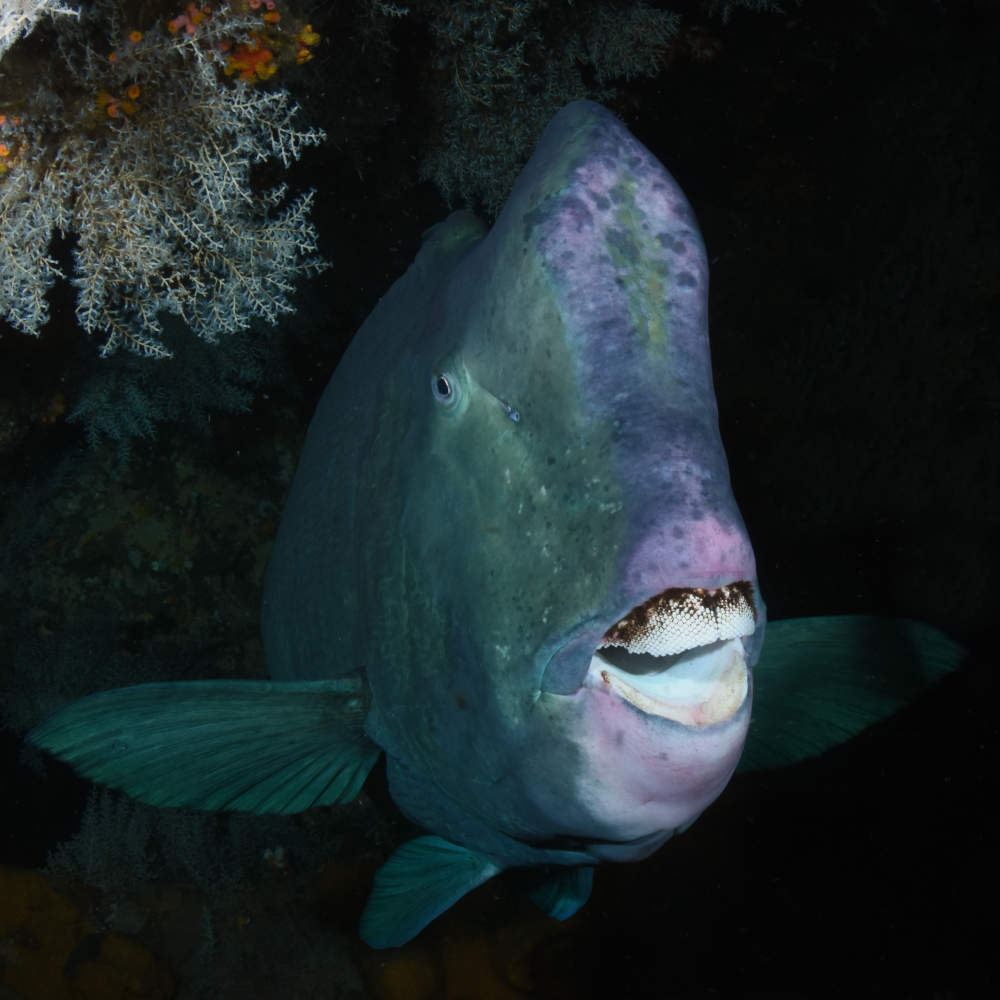
Scientifically described by Valenciennes (1840) from the Scariidae family, the gregarious omnivore is found throughout the Indo-Pacific Ocean, in the Red Sea around Wake Islands, Yaeyama, and the Great Barrier Reef.
This humped marine creature reaches up to 130 cm (4.3 ft) and 46 kg (101 lb). Its buck teeth are partly covered by its lips. About 15 rows of 1000 fused teeth form a beak-like structure of parrots – this lies true for all parrotfish.
The bumphead parrotfish uses strong teeth to munch on corals, algae, and even limestone. It’s also said that parrotfish teeth are harder than even some metals.
Which Fish have Sharp Teeth?
Now, if you like to swim in natural water bodies, make sure you’re not around any of the following fishes. They all have a bad rap about sharp teeth that can lead to a blood bath.
8. Alligator Gar (Atractosteus spatula)
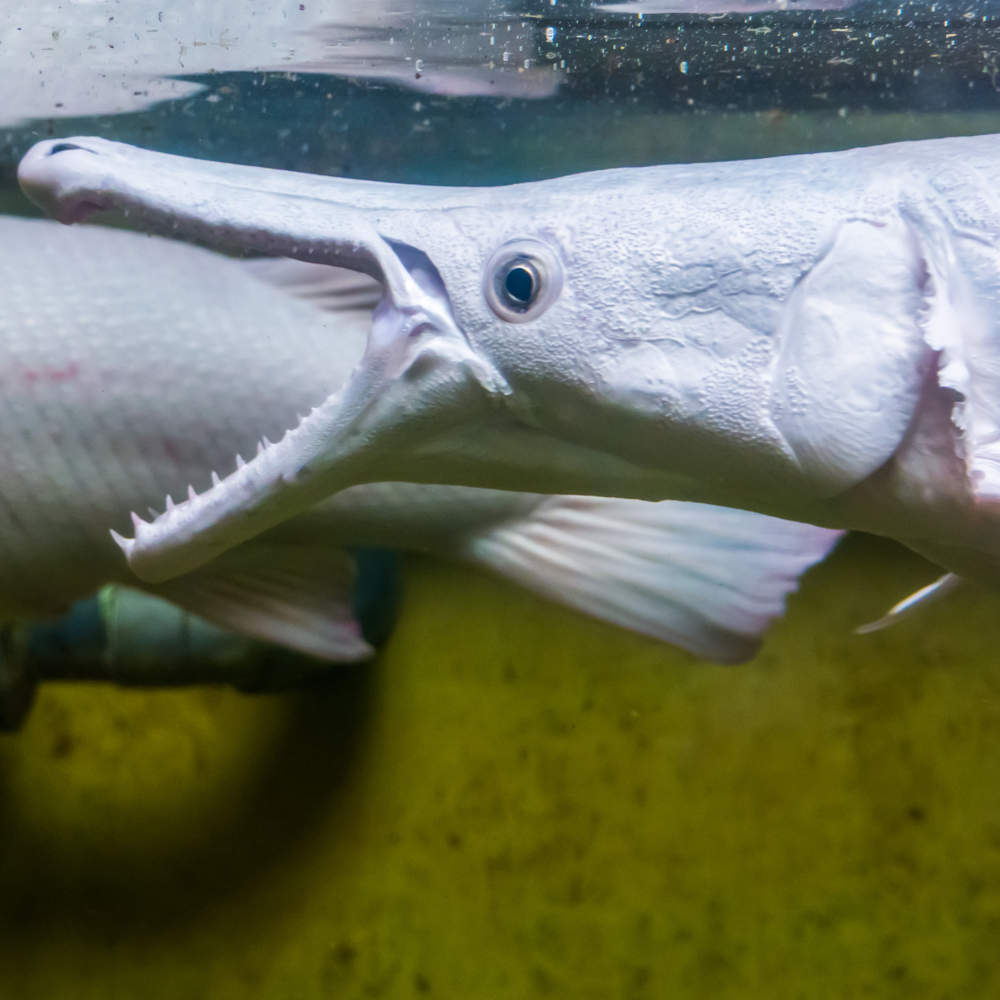
The torpedo-shaped euryhaline alligator gar from the Lepisosteidae family is native to the Mississippi River and Gulf of Mexico coastal plain from the Econfina River. Its latest scientific name was given by Wiley (1976).
This 10-foot-long docile night predator’s teeth are comparable in size to that of most large fishes and strong enough to penetrate through bones. The carnivore has sharp saw-edged incisors, pointy straight or curved canines, and broad and flat molars.
Though it’s known to have 80 teeth, it loses about 2000-3000 teeth in its lifetime. Compared to other gars, it has double rows of sharp dentition in the upper jaw.
9. Humpback Anglerfish (Melanocetus johnsonii)

Native to the temperate and tropical regions of the South and East China Seas, the Lophiiformes fish was first discovered near Madeira (1863) by English naturalist James Yates Johnson.
The intimidating-looking humpback anglerfish has several rows of long, pointy, sharp teeth, assisting it to dine on even larger species. Its prey gets locked in between its durable teeth.
Male counterparts of this carnivore have more teeth but don’t have the luminescent fin ray necessary to attract prey. So, they often connect their circulatory system with a female using their teeth. This helps the males survive like a parasite by extracting the nutrition.
What are Fish with Ugly Teeth?
Some species’ teeth may just run a shiver down your spine because of how weird and eerie they look, like the following…
10. Atlantic Wolffish (Anarhichas lupus)
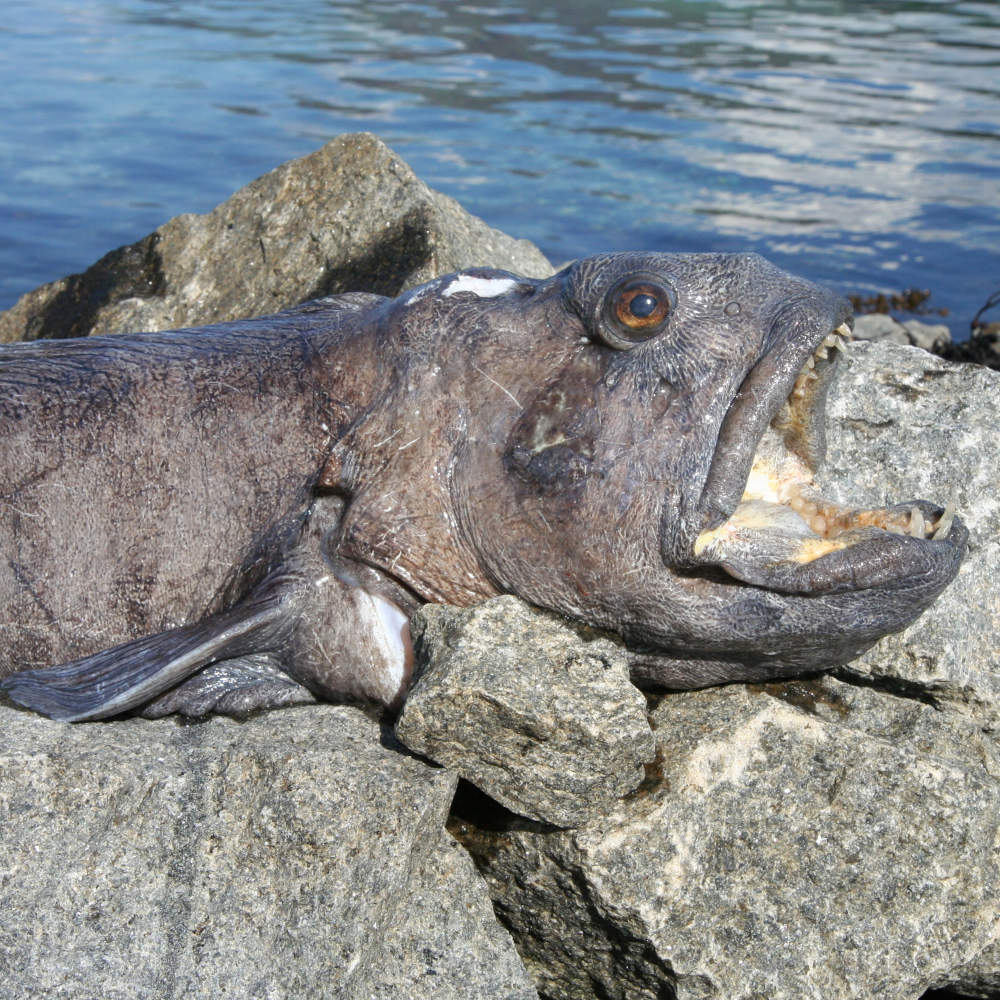
Hailing from the North Atlantic Ocean, the marine Anarhichadidae family member grows up to 150 cm (4.9 ft) and 23.6 kg (52 lb).
The eel-like carnivorous Atlantic wolffish is named after its front 4-6 canine-like teeth on both jaws. Behind these conical fangs, there are 3 rows of crushing teeth, 4 molars on the upper jaw, and 2 rows of molars on the lower jaw.
There are also scattered serrated teeth in its throat, which makes the territorial and aggressive fish’s mouth really scary.
11. Black Piranha (Serrasalmus rhombeus)
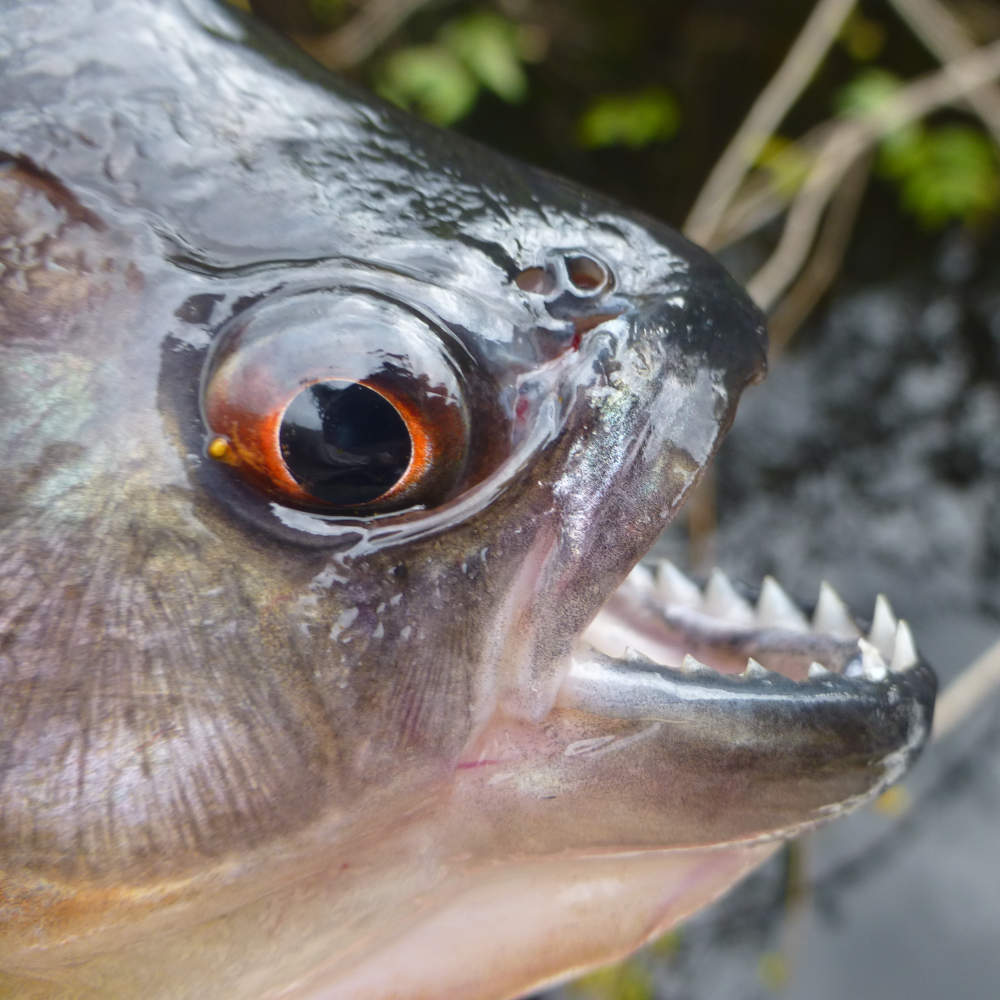
The Serrasalmidae family species, found in the Amazon and Orinoco drainages and Essequibo River of South America, grows up to 41.5 cm (1.4 ft) and 3 kg (6.6 lb) and was described by Linnaeus (1758).
This rhombus-shaped freshwater omnivore has a protruding powerful jawline to house its scary razor-sharp teeth. It’s known to bite off people’s fingers and toes and attack boats.
Its powerful bite can puncture a few fold bigger creatures.
12. Payara (Hydrolycus scomberoides)
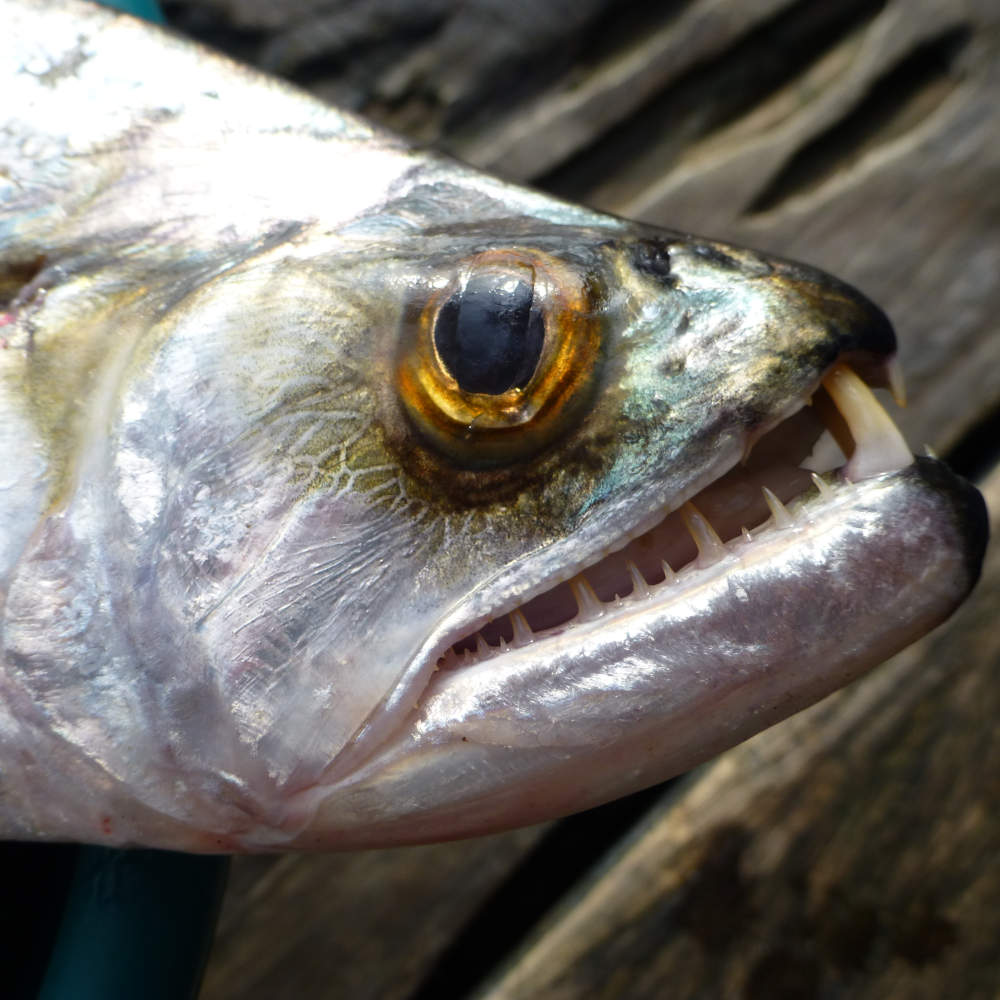
This freshwater dogtooth tetra of the Cynodontidae family, described by Cuvier (1819), spotted in the Amazon Basin (South America), can be 51 cm (1.7 ft) long and 17.8 kg (39 lb) heavy.
Named after its vampire-like fangs on the lower jaws that can reach up to 6 inches. Payara even has fang sockets on the upper jaw that help it close its mouth properly.
The highly aggressive predator’s bite is often compared to that of cobra’s. It even feasts on the scary piranhas, proving the strength of its dentures.
13. Map Pufferfish (Arothron mappa)
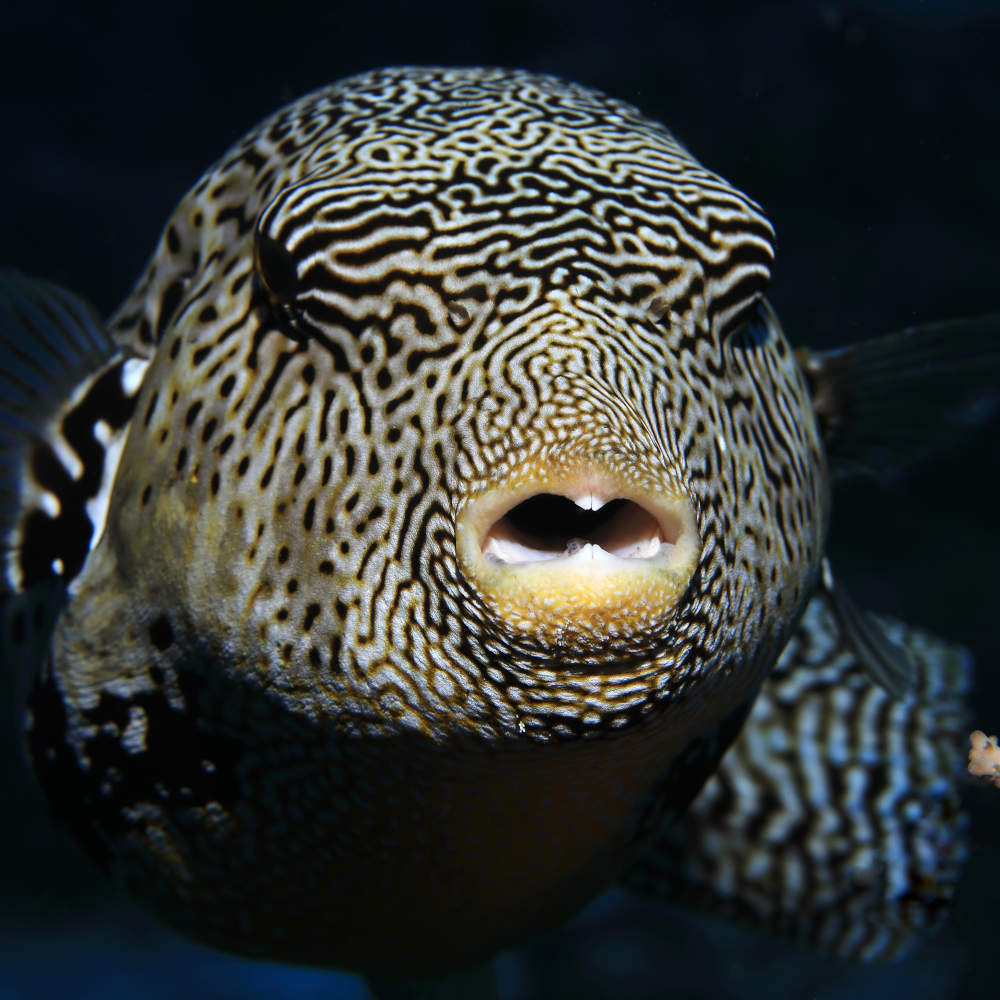
Native to tropical and subtropical regions of the West Pacific and Indian Oceans, the 65-cm (2 ft) elongated fish belongs to the Tetradontidae family and was described by Linnaeus (1758).
The shy yet territorial marine carnivore has four robust teeth fused to form a sharp beak. Its teeth continuously grow throughout its life. The map pufferfish has to consistently wear them away by biting on hard-shelled prey.
Which Fish Species have the Most Number of Teeth?
If you’re curious about which fish has the “toothiest” grin, there are quite a few competitors for the top spot. So, let’s introduce them all here…
14. Lingcod (Ophiodon elongatus)
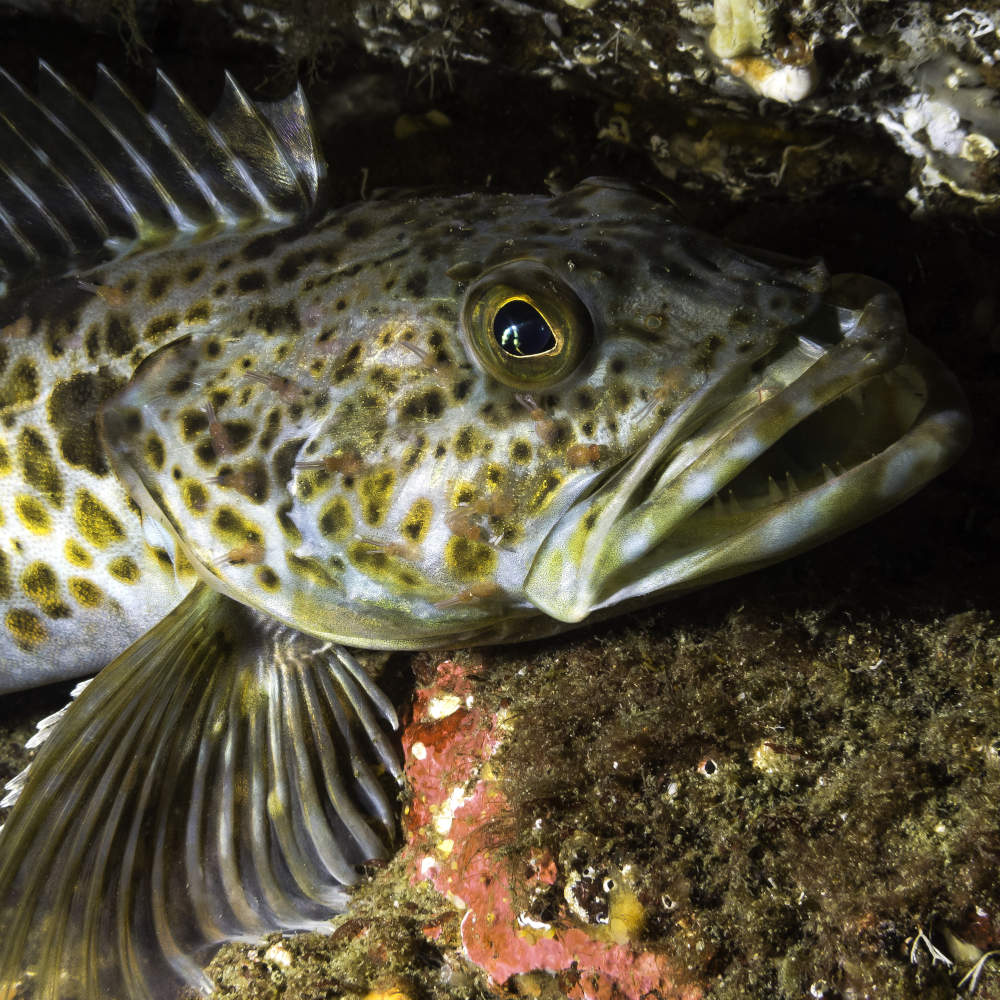
Hailing from the Hexagrammidae family and described by Girard (1854), the fierce marine carnivore is the only existing species of its genus. Found in the Northeast Pacific Ocean and Bering Sea, the lingcod reaches up to 152 cm (5 ft) and 59 kg (130 lb).
Popular for having the most teeth, i.e., about 555, it also loses 20 teeth every day! These sharp and near-microscopic teeth are on its regular jaws, pharyngeal jaws, and hard palate. The teeth help the fish firmly grab, tear through the prey’s skin, and grind them.
Its teeth fossilize well, so some even refer to the species as the “most abundant artifact in the fossil record.”
15. Great White Shark (Carcharodon carcharias)
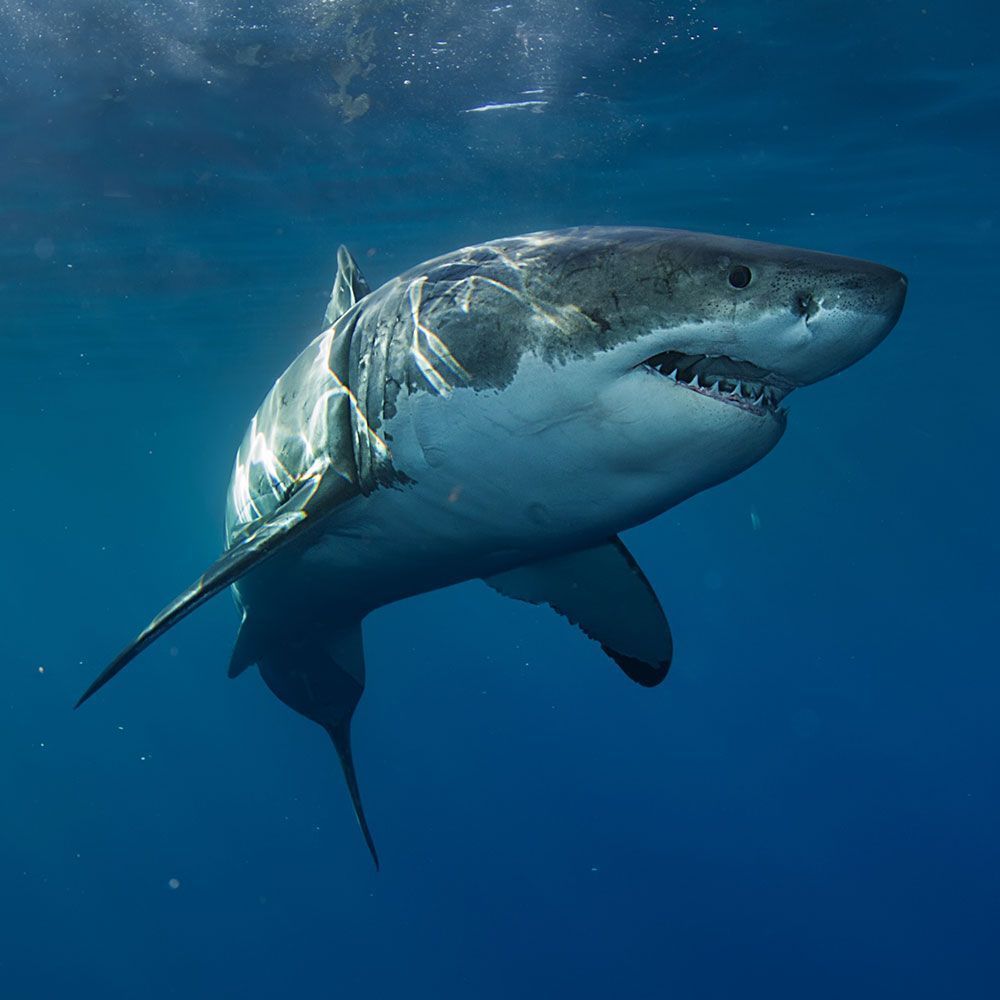
The most feared sea carnivore of the world from the Lamnidae family hardly needs any introduction. Found worldwide and described by Linnaeus (1838), it grows up to 640 cm (21 ft).
It has 300 teeth at once – with the biggest teeth about 2.5-3 in long – and can grow almost 30,000 teeth throughout its lifetime. Only 25 and 28 teeth on the lower and upper jaw, respectively, are visible from the outside. But several more rows are present behind.
These teeth shape and size a lot – some are large, triangular, flat, serrated, and so on. They all help the great white shark capture prey and pierce its flesh brutally. Its bite force is about 4,000 PSI. The shark is also known to regenerate an entire new set of teeth within 2 weeks.
16. Northern Pike (Esox lucius)

From the Esocidae family, the aggressive carnivore – native to the freshwater and brackish water systems of North America, Europe, and Central Asia – is known to reach 150 cm (4.9 ft) and 28 kg (62 lb). It’s described by Linnaeus (1758)
The northern pike has the most teeth – 300-700. However, it still can’t be labeled as the “fish with most teeth” as the number of teeth varies. The 2-cm-long sharp, inward-angled teeth effectively hold, tear, and immobilize its prey. All these teeth cover the fish’s jaws, tongue, and gill rakers.
This species replaces about 100 teeth a year. It’s also popular for having flexible, bendy teeth that only go further back and not forward. But the fish can’t consciously move its teeth.
17. Muskie Fish (Esox masquinongy)

Popular as the largest Esocidae family member (pike), the up-to-180-cm-long (5.9 ft) aggressive carnivore is found in clear vegetated North American Great Lakes and Red and Mississippi Rivers. It was scientifically named by S. L Mitchill (1824).
The freshwater muskie has a mouth full of 500-700 razor-edged teeth up to some inch-long big canines and a majority of 1/16-1/8 inch needle-like inward-facing dentitions. The smaller teeth are present on the roof of its mouth and tongue, which prevents its prey from escaping.
Its bite force is 1200 PSI, so it can also bite through fishing lines and human limbs.
Teeth of Other Notable Species
The above fish were the most talked-about when it comes to fish teeth. However, there are a few more quirky ones that often get overlooked. C’mon, let’s know about them here…
18. Bluefish (Pomatomus saltatrix)
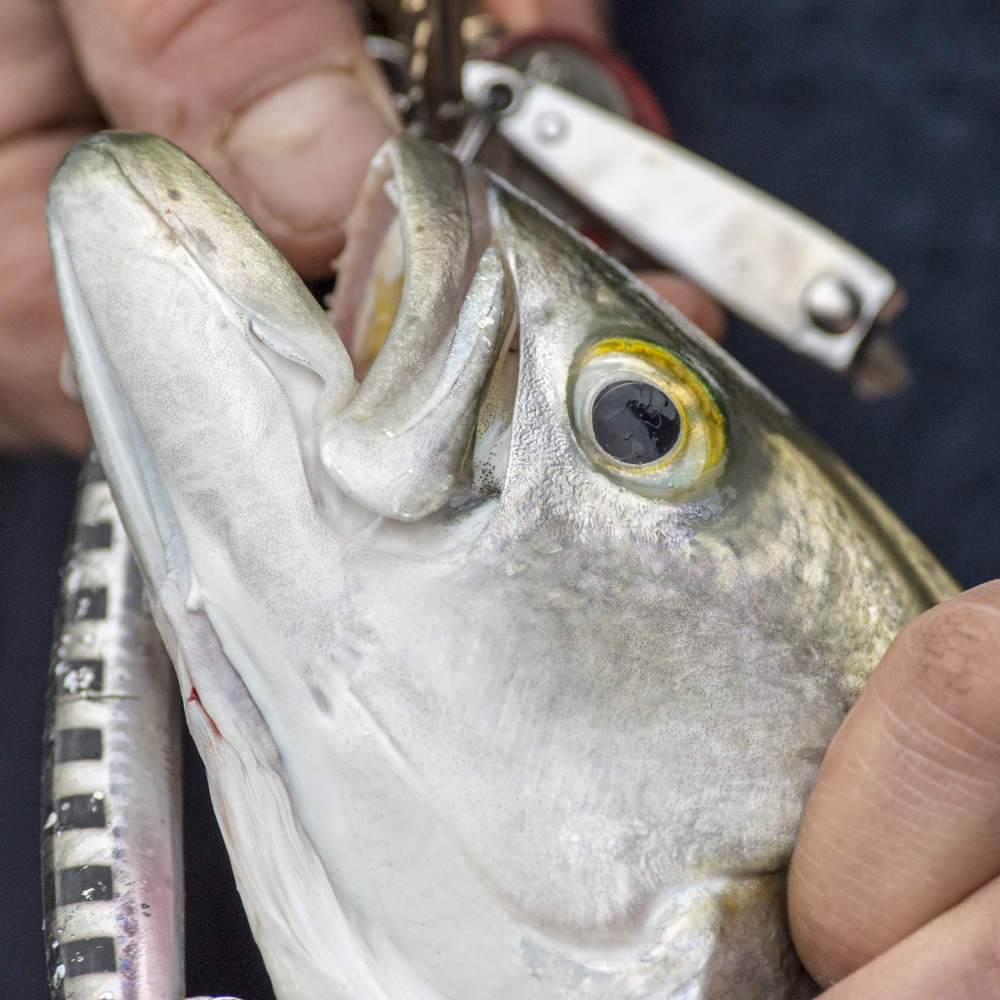
This carnivore of the Pomatomidae family marks its territory around the tropical and subtropical waters of the Eastern and Western Atlantic, Indian, and Southwest Pacific Oceans. It was described by Linnaeus (1766).
Known to be up to 130 cm (4.3 ft) long, the middle-to-top dwelling bluefish has a single row of highly uniform-sized and identical teeth on both prominent jaws.
All teeth are conical, knife-edged, sharp, and compressed. The strong teeth make its jaws like shears, helping it chomp on huge prey. It’s also known to attack human beings.
19. Bowfin (Amia calva)
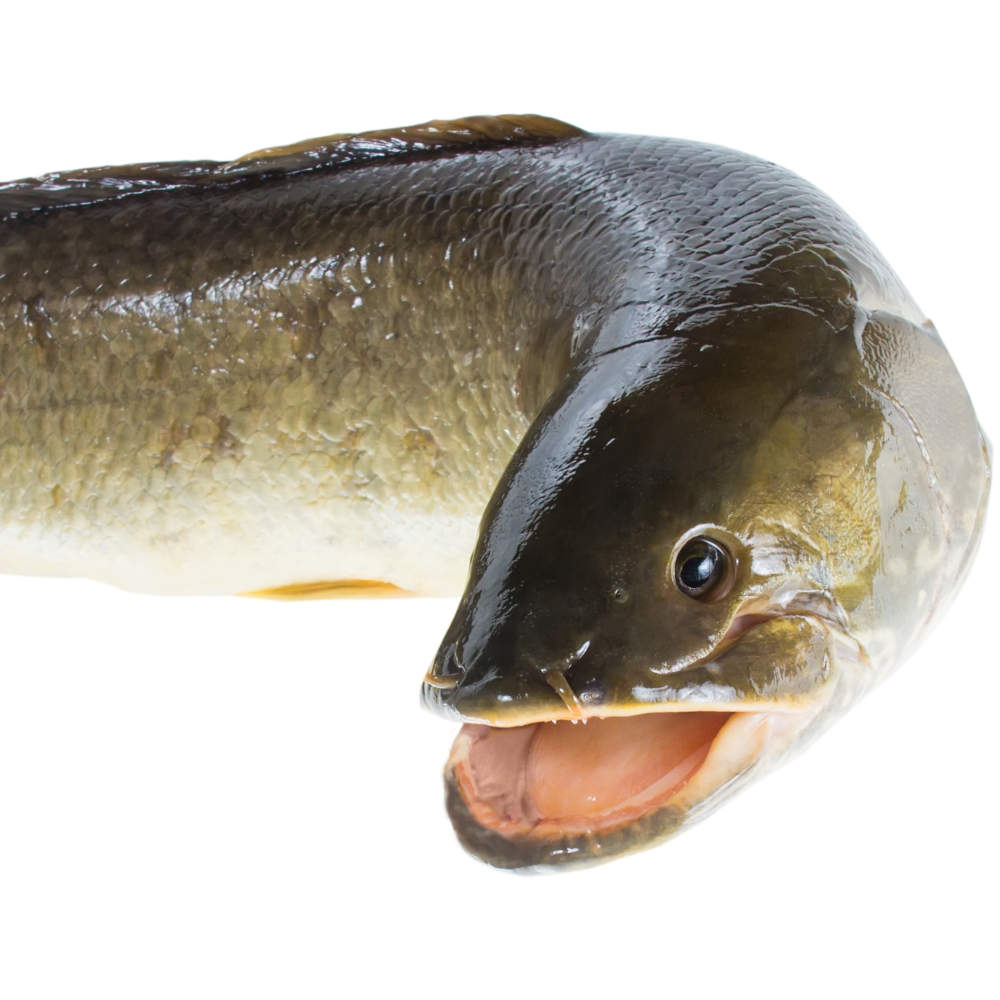
This freshwater bottom-dweller of the Amiidae family, spotted in the St. Lawrence River, Great Lakes, Mississippi River basins, Susquehanna River drainage, and Colorado River, can reach 109 cm (3.6 ft) in length. Its binomial name was assigned by Linnaeus (1766).
The territorial adult bowfin has conical, sharp, and strong teeth (much like the teeth of tyrannosaurus rex) on its powerful jaws. Thus, the fish can pierce flesh easily.
With its strong and swift bite, it’s known to hunt its prey in an average of 0.075 seconds. The fish also has a bad reputation for hurting fishermen severely.
20. Goliath Tigerfish (Hydrocynus goliath)
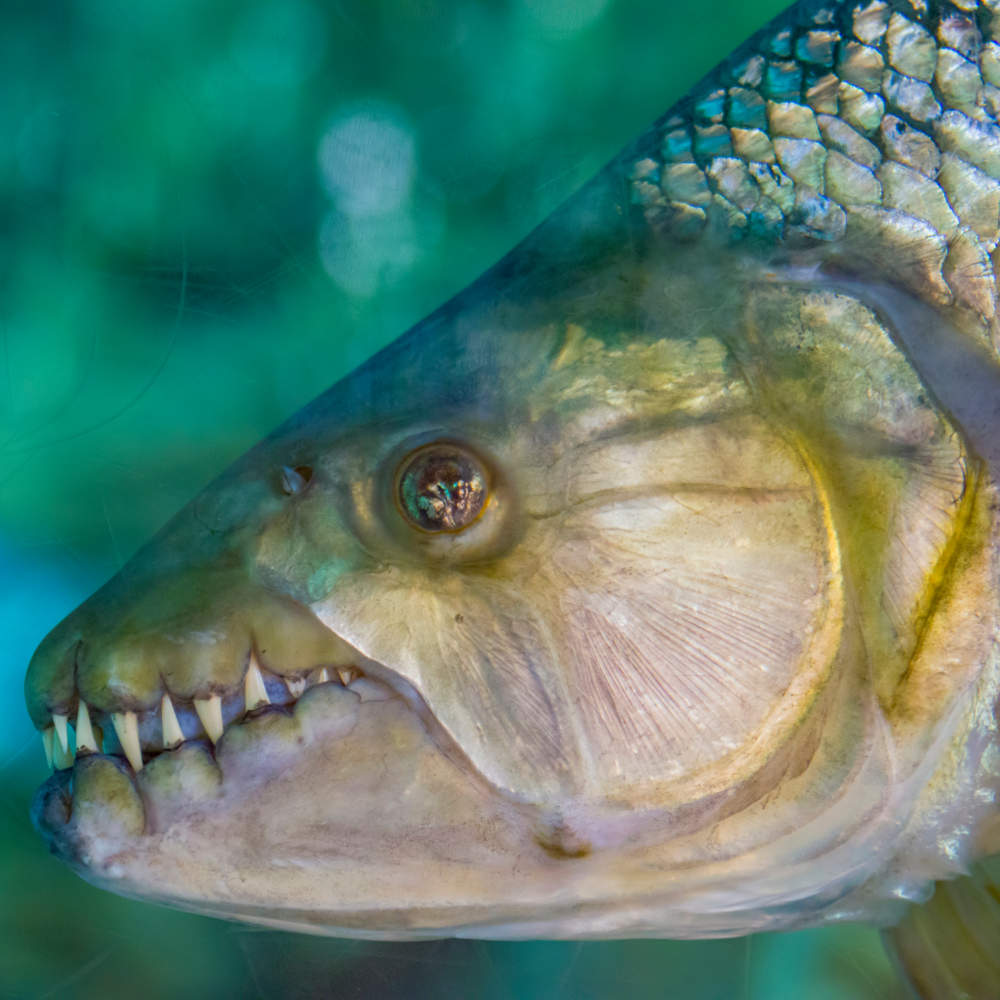
This aggressive ambush predator from the Congo River and Lake Tanganyika, Africa, growing up to 133 cm (4 ft), belongs to the Alestidae family. The fish was scientifically named by Boulenger (1898).
It has up to 32 razor-sharp dagger-like teeth, with each an inch long. Thus, it’s also called a “super-sized piranha.” The fierce goliath tigerfish is infamous for clamping down its strong jaws and slicing its prey in a single bite.
This freshwater surface-dweller hunts other fish, reptiles, mammals, and even birds. When provoked, it attacks humans. Fishermen have also lost fingers to it.
21. Black Drum Fish (Pogonias cromis)
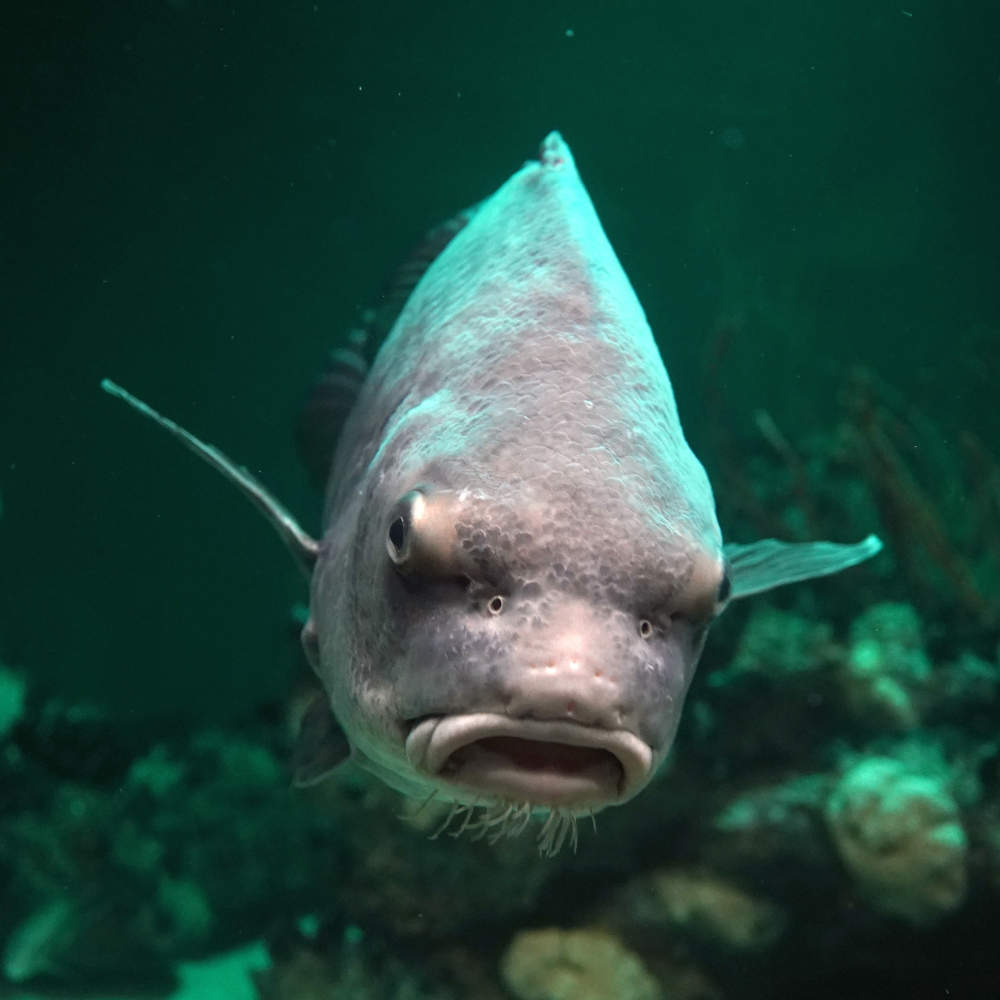
The Scianidae family member, scientifically described by Linnaeus (1766), belonging to the brackish water around the Western Atlantic Ocean and Orinoco delta, can be 170 cm (5.6 ft) long.
This highly aggressive bottom-feeding carnivore has a throat full of tightly-packed pharyngeal molariform cusps to crush shells of shellfish and crustaceans. These teeth are visible only when you lift its gill cover.
It also has tiny, sharp, and pointy teeth on its jaws. The black drum has extremely strong jaws with a bite force of 11,000 Newtons – which is often compared to a crocodile’s bite.
22. Wahoo Fish (Acanthocybium solandri)

Belonging to the Scombridae family and described by Cuvier (1831), the middle-dwelling aggressive predator is native to tropical and subtropical regions of the Indian, Pacific, and Atlantic Oceans.
Known to reach 250 cm (8.2 ft) and 83 kg (183 lb)), the wahoo has razor-edged teeth on both scissor-like jaws. The triangular chompers are similar to king mackerel but slightly shorter and more closely packed.
Its strong bite can swiftly cut through the flesh and bones of prey. The species can have 100-120 teeth.
23. Betta Fish (Betta splendens)
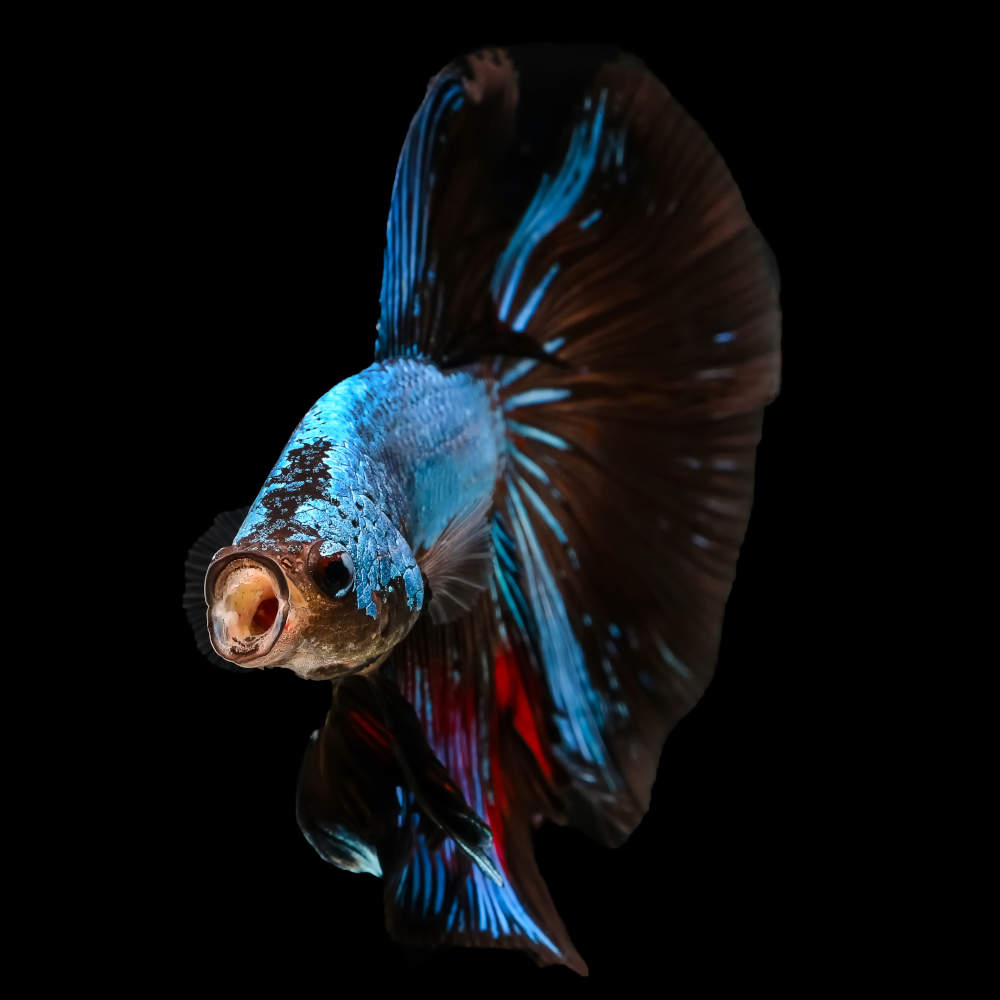
Native to the Chao Phraya and Mekong Basins of Asia and reaching up to 8 cm (3.2 in), the territorial betta fish belongs to the Osphronemidae family and was described by Regan (1910).
Do betta fish have teeth?
On this list, the voracious carnivore, betta fish has the smallest teeth. In fact, you’d need magnifying glasses to notice the torpedo-shaped betta’s razor-sharp white biters. The teeth are used for hunting, feeding, and even fighting with others.
However, the middle-to-top dweller can’t hurt humans. Instead, its jaw may get stuck to human skin, which may hurt the fish.
A word from FishInAquarium
All fish species have unique teeth catering to their particular diet, survival, and even defense needs. In conclusion, the listed mesmerizing fish have all evolved according to their surroundings, behaviors, and lifestyles.
With that said, if you enjoyed this article and are satisfied with the unique information, share it with other enthusiasts! Discuss all the details and go gaga over it.
And in case you guys have more questions, drop us an email, and we’ll get back to you!

